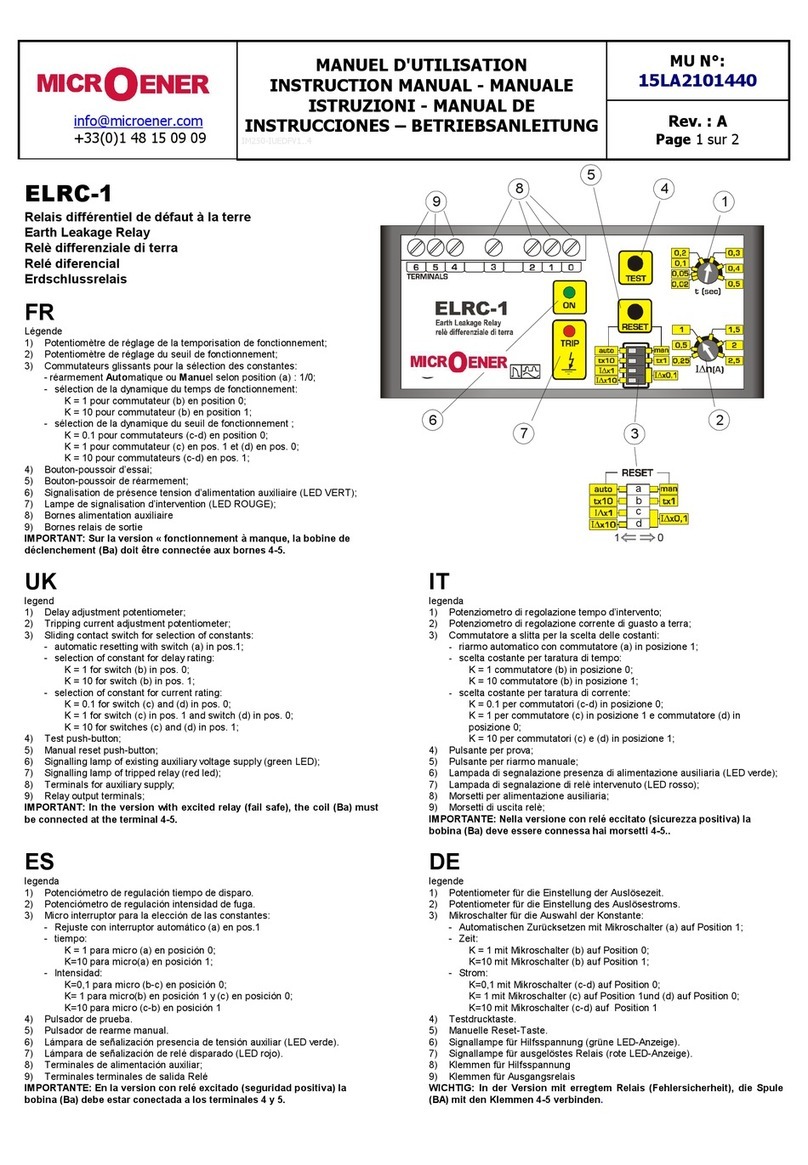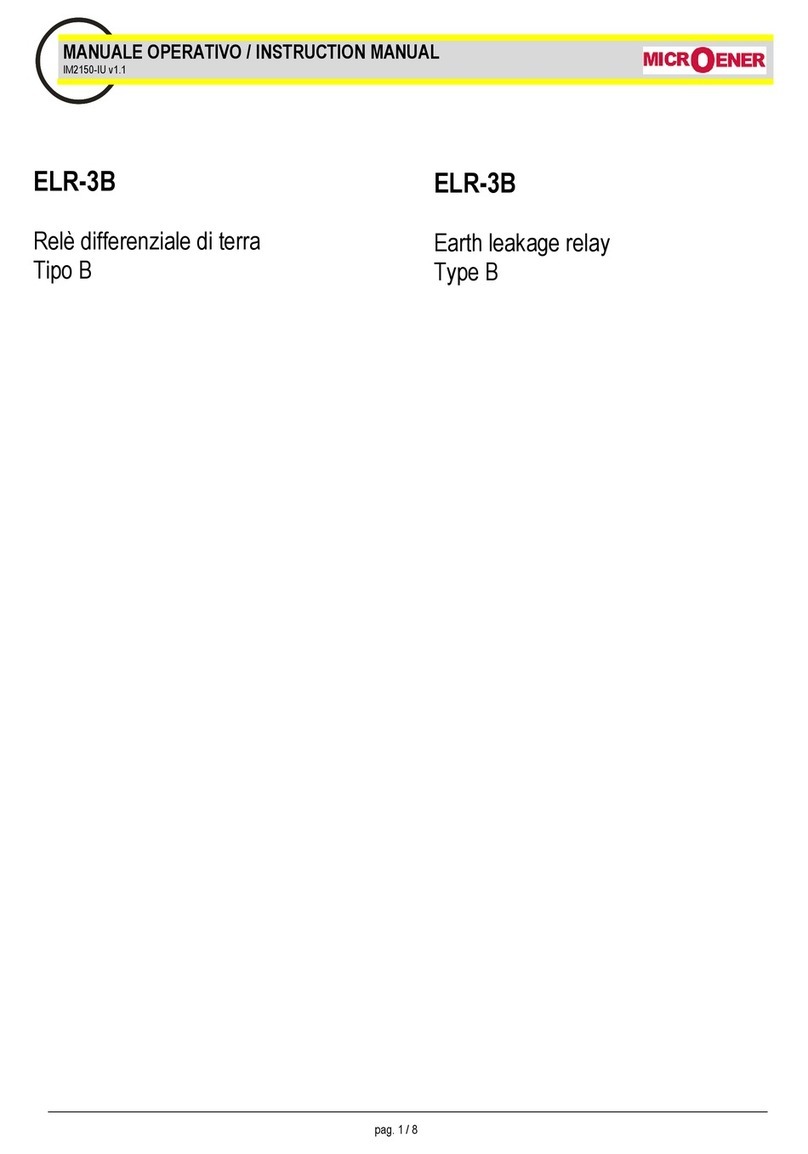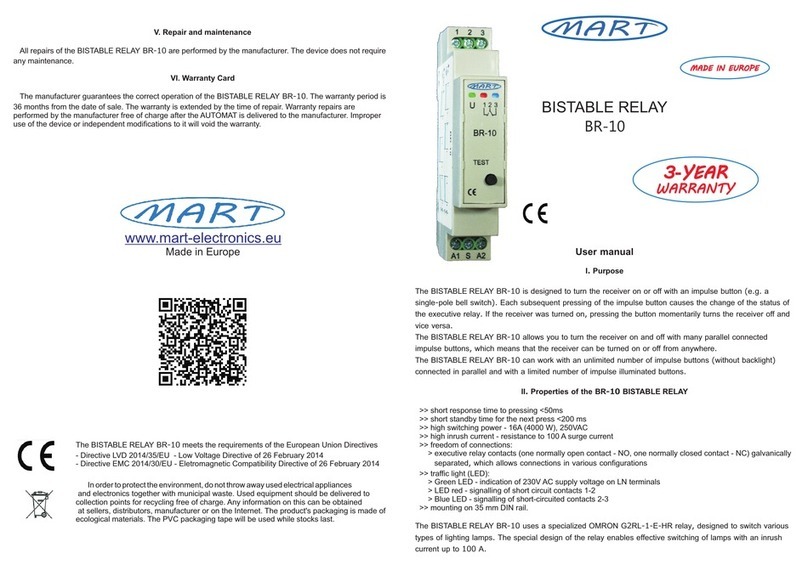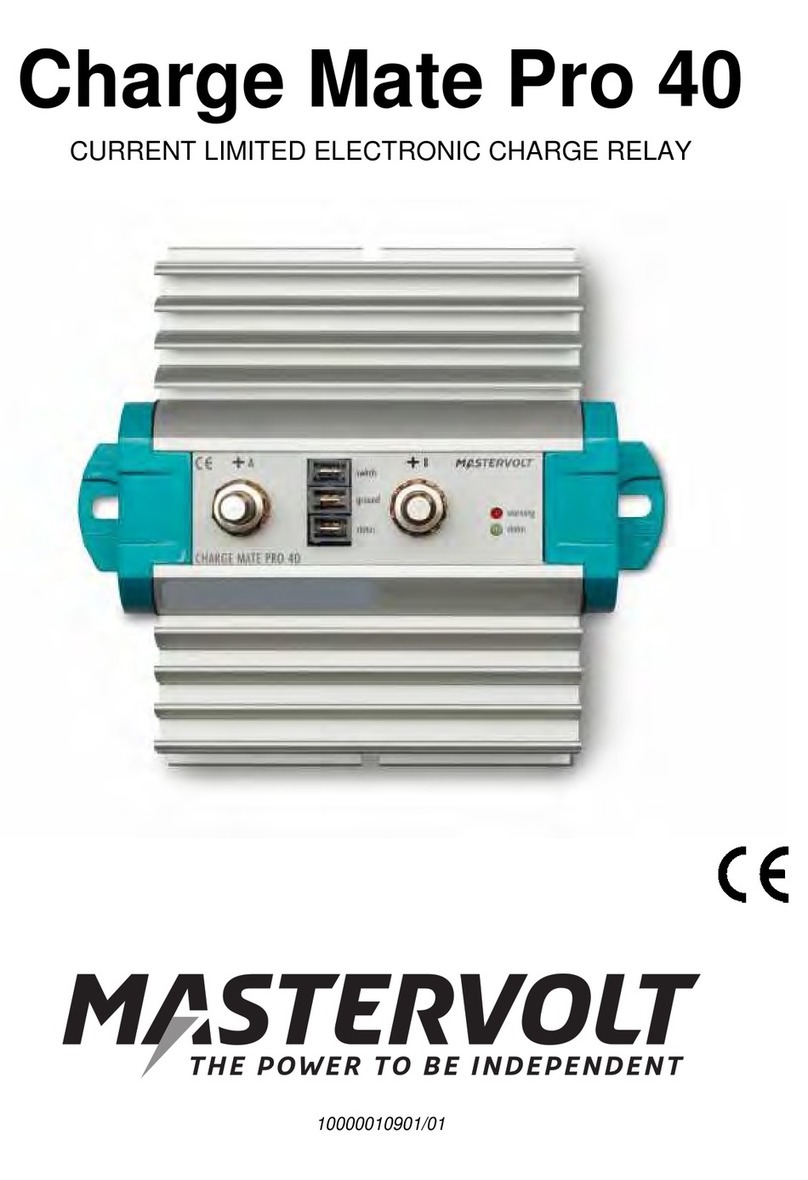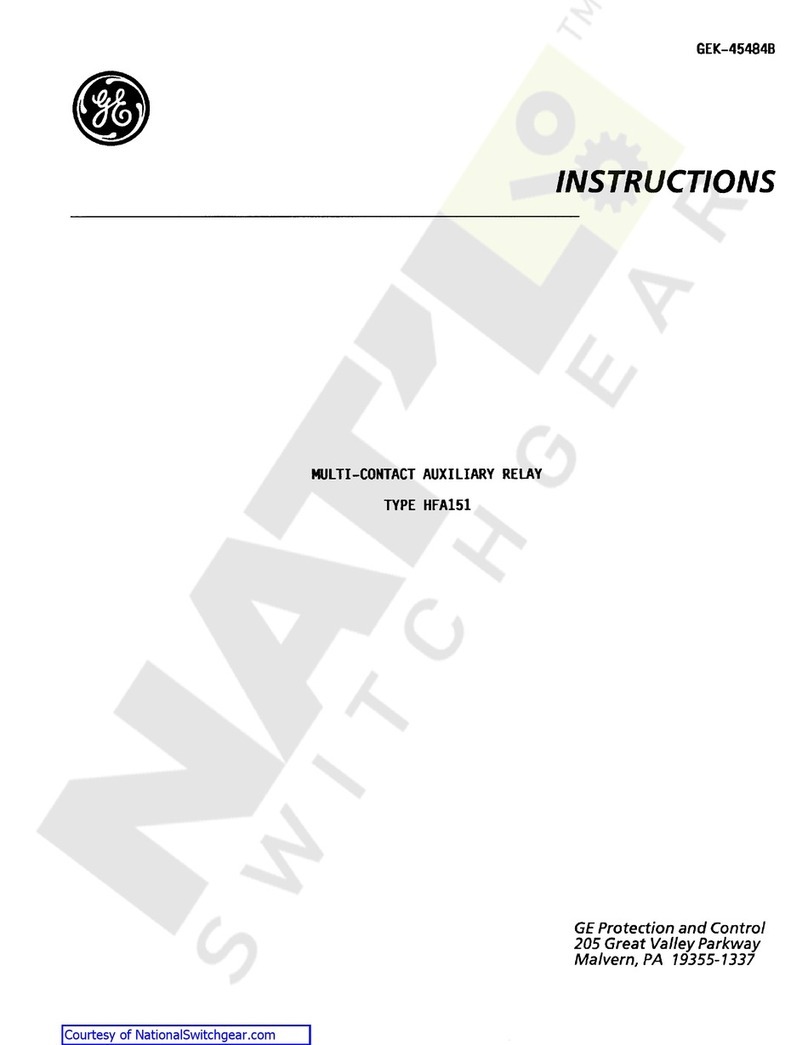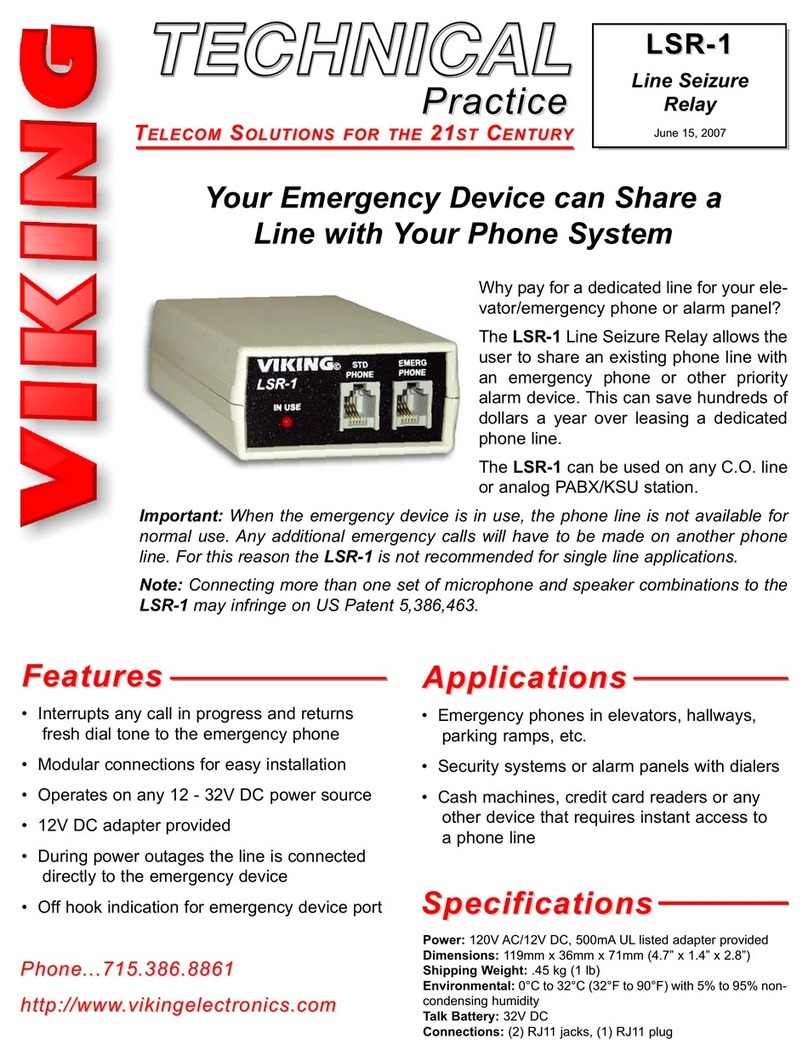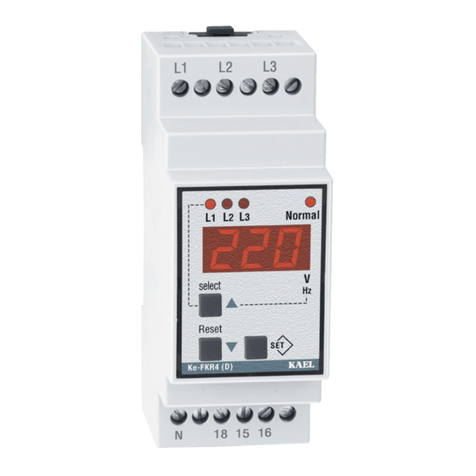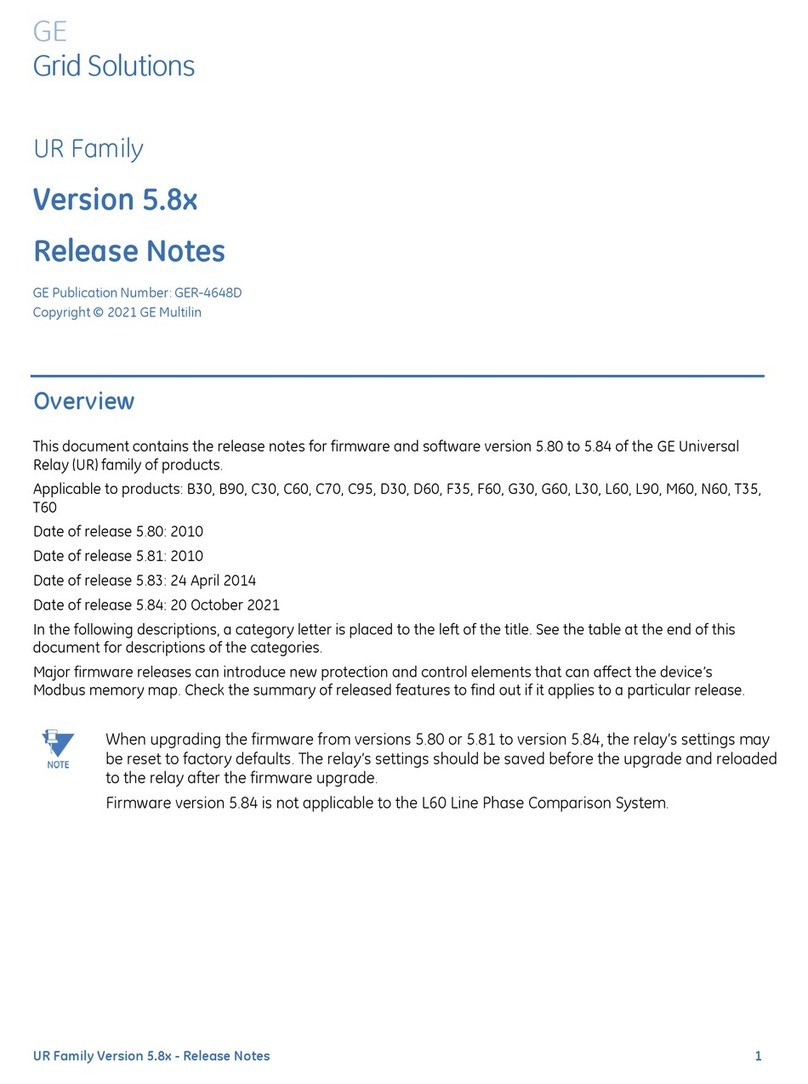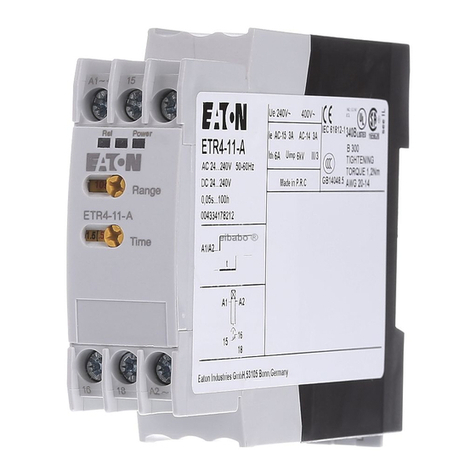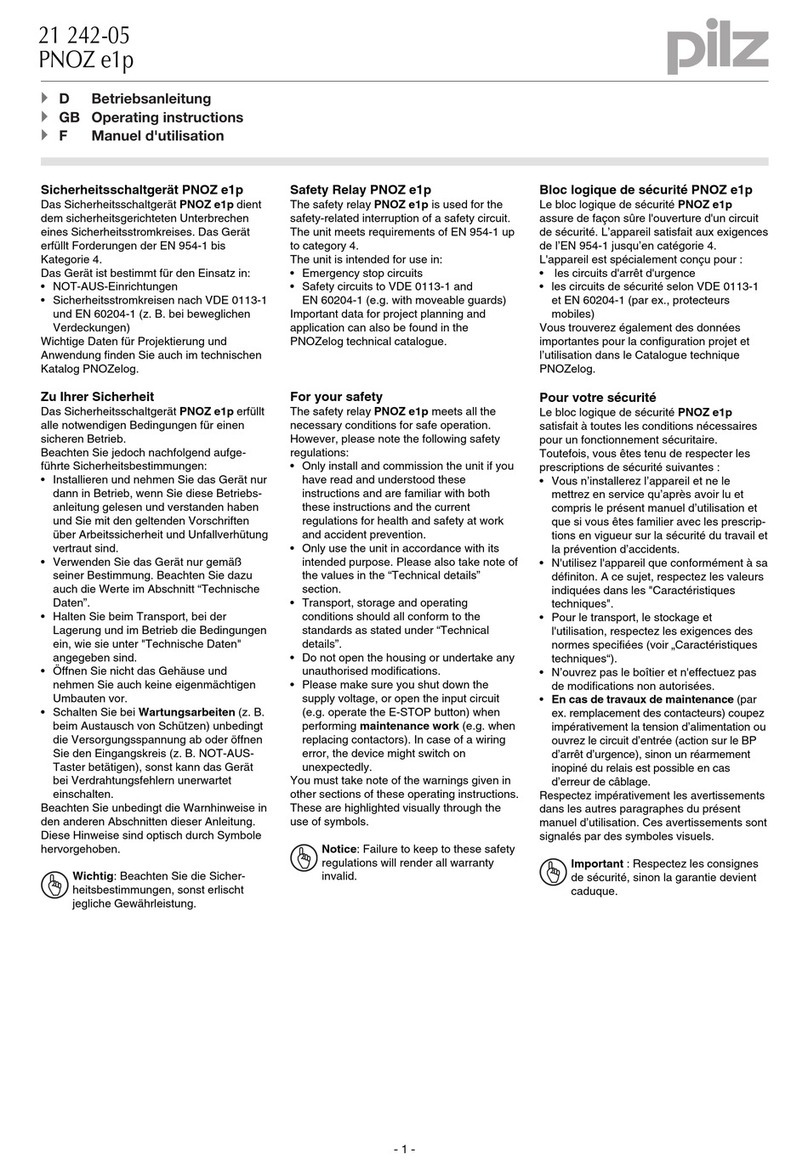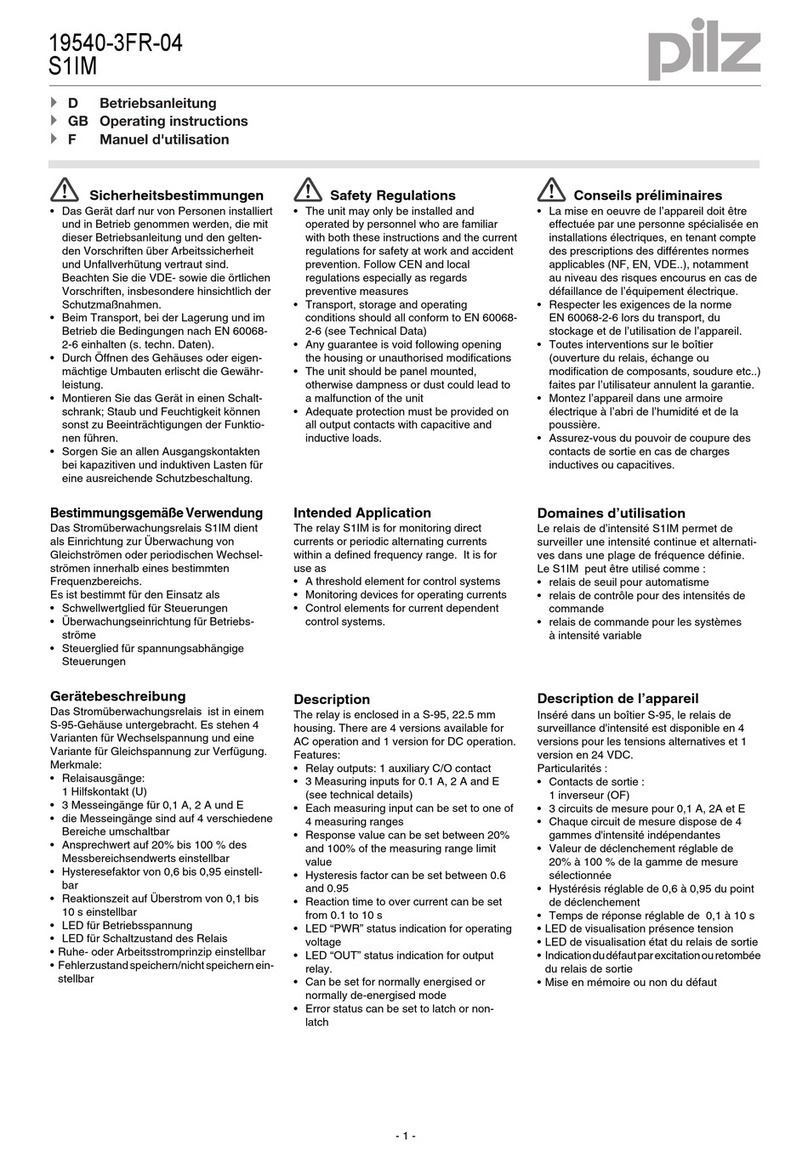MICROENER IM30-DK User manual

IM30-DK
Doc. N° MO-0040-ING
Rev. 2
Pag. 1 of 34
Copyright 2010 Microener
MICROPROCESSOR OVERCURRENT
AND DIRECTIONAL EARTH FAULT
PROTECTION RELAY
TYPE
IM30-DK
OPERATION MANUAL
MULTIFUNCTION
OVERCURRENT +
DIRECTIONAL
EARTH FAULT
RELAY TYPE
IM30-DK
ENTER/RESET
MODE
SELECT
+
-
PROG.
I>>/>>>
Io>
PROG/
I.R.F.
MICROELETTRICA SCIENTIFICA
MILANO ITALY
I>
Io>>/>>>
BR.FAIL
I2t
Uo>
BLOCK
INPUT

IM30-DK
Doc. N° MO-0040-ING
Rev. 2
Pag. 2 of 34
Copyright 2010 - Microener
INDEX
1 General utilization and commissioning directions __________________________________________3
1.1 Storage and transportation__________________________________________________________ 3
1.2 Installation_______________________________________________________________________ 3
1.3 Electrical connection_______________________________________________________________ 3
1.4 Measuring inputs and power supply___________________________________________________ 3
1.5 Outputs loading___________________________________________________________________ 3
1.6 Protection earthing_________________________________________________________________3
1.7 Setting and calibration______________________________________________________________ 3
1.8 Safety protection__________________________________________________________________ 3
1.9 Handling_________________________________________________________________________3
1.10 Maintenance_____________________________________________________________________ 4
1.11 Fault detection and repair___________________________________________________________ 4
2 General characteristics and operation____________________________________________________ 4
2.1 Power supply_____________________________________________________________________ 4
2.2 Operation and Algorithms___________________________________________________________ 5
2.2.1 Input quantities_______________________________________________________________ 5
2.2.2 Algorithm of the time current curves_______________________________________________ 6
2.2.3 Automatic doubling of the overcurrent pick-up level___________________________________ 7
2.3 Operation of the directional earth fault element___________________________________________8
2.4 Interlocking logic__________________________________________________________________ 10
2.5 Instantaneous outputs and lock-out logic_______________________________________________ 10
2.4 Function blocking inputs____________________________________________________________ 10
2.5 Breaker failure protection____________________________________________________________10
2.6 Breaking energy accumulation_______________________________________________________ 11
2.7 Clock and Calendar________________________________________________________________ 13
2.7.1 Clock synchronization__________________________________________________________ 13
2.7.2 Date and time setting__________________________________________________________ 13
2.7.3 Time resolution_______________________________________________________________ 13
2.3.4 Operation during power off______________________________________________________ 13
2.7.5 Time tolerance_______________________________________________________________ 13
3 Controls and measurements____________________________________________________________ 14
4 Signalization_________________________________________________________________________ 15
5 Output relays_________________________________________________________________________16
6 Serial communication__________________________________________________________________16
7 Digital inputs_________________________________________________________________________17
8 Test________________________________________________________________________________ 17
9 Keyboard and display operation_________________________________________________________ 18
10 Reading of measurements and recorded parameters________________________________________19
10.1 ACT. MEAS (Actual measure)___________________________________________________ 19
10.2 MAX VAL (Max values)_______________________________________________________19
10.3 LASTTRIP (Last trip)_________________________________________________________ 20
10.4 TRIP NUM (Trip number)______________________________________________________ 20
11 Reading of programmed settings and relay’s configuration__________________________________ 20
12 Programming_________________________________________________________________________21
12.1 Programming of functions settings________________________________________________ 21
12.2 Programming the configuration of output relay_______________________________________ 23
13 Manual and automatic test operation_____________________________________________________ 24
13.1 Mode “ TESTPROG “ subprogram “ W/O TRIP “_____________________________________ 24
13.2 Mode “ TESTPROG “ subprogram “ With TRIP “_____________________________________ 24
14 Maintenance_________________________________________________________________________ 24
15 Power frequency insulation test_________________________________________________________ 24
16 Electrical characteristics_______________________________________________________________ 25
17 Connection diagram (Standard Output)____________________________________________________ 26
18 Wiring the serial communication bus_____________________________________________________27
19 Change phase rated input 1A or 5A______________________________________________________ 27
20 Time current curves IEC_______________________________________________________________ 28
21 Time current curves IEEE______________________________________________________________ 29
22 Direction for pcb’s draw-out and plug-in__________________________________________________ 30
22.1 Draw-out____________________________________________________________________ 30
22.2 Plug-in______________________________________________________________________30
23 Overall dimensions____________________________________________________________________31
24 Keyboard operational diagram__________________________________________________________ 32
25 Setting’s form - Commissioning Test Record______________________________________________ 33

IM30-DK
Doc. N° MO-0040-ING
Rev. 2
Pag. 3 of 34
Copyright 2010 - Microener
1. General utilization and commissioning directions
Always make reference to the specific description of the product and to the Manufacturer's instruction.
Carefully observe the following warnings.
1.1 - STORAGE AND TRANSPORTATION
must comply with the environmental conditions stated on the product's instruction or by the applicable
IEC standards.
1.2 - INSTALLATION
must be properly made and in compliance with the operational ambient conditions stated by the
Manufacturer.
1.3 - ELECTRICAL CONNECTION
must be made strictly according to the wiring diagram supplied with the Product, to its electrical
characteristics and in compliance with the applicable standards particularly with reference to human
safety.
1.4 - MEASURING INPUTS AND POWER SUPPLY
carefully check that the value of input quantities and power supply voltage are proper and within the
permissible variation limits.
1.5 - OUTPUTS LOADING
must be compatible with their declared performance.
1.6 - PROTECTION EARTHING
When earthing is required, carefully check its efficiency.
1.7 - SETTING AND CALIBRATION
Carefully check the proper setting of the different functions according to the configuration of the
protected system, the safety regulations and the co-ordination with other equipment.
1.8 - SAFETY PROTECTION
Carefully check that all safety means are correctly mounted, apply proper seals where required and
periodically check their integrity.
1.9 - HANDLING
Notwithstanding the highest practicable protection means used in designing M.S. electronic circuits,
the electronic components and semiconductor devices mounted on the modules can be seriously
damaged by electrostatic voltage discharge which can be experienced when handling the modules.
The damage caused by electrostatic discharge may not be immediately apparent but the design
reliability and the long life of the product will have been reduced. The electronic circuits reduced by
M.S. are completely safe from electrostatic discharge (8 KV IEC 255.22.2) when housed in their
case; withdrawing the modules without proper cautions expose them to the risk of damage.

IM30-DK
Doc. N° MO-0040-ING
Rev. 2
Pag. 4 of 34
Copyright 2010 - Microener
a. Before removing a module, ensure that you are at the same electrostatic potential
as the equipment by touching the case.
b. Handle the module by its front-plate, frame, or edges of the printed circuit board.
Avoid touching the electronic components, printed circuit tracks or connectors.
c. Do not pass the module to any person without first ensuring that you are both at
the same electrostatic potential. Shaking hands achieves equipotential.
d. Place the module on an antistatic surface, or on a conducting surface which is at
the same potential as yourself.
e. Store or transport the module in a conductive bag.
More information on safe working procedures for all electronic equipment can be found
in BS5783 and IEC 147-OF.
1.10 MAINTENANCE
Make reference to the instruction manual of the Manufacturer ;
maintenance must be carried-out by specially trained people and in strict conformity
with the safety regulations.
1.11 FAULT DETECTION AND REPAIR
Internal calibrations and components should not be alterated or replaced.
For repair please ask the Manufacturer or its authorised Dealers.
Misapplication of the above warnings and instruction relieves the Manufacturer of any liability.
2. GENERAL CHARACTERISTICS
Input quantities are supplied to 1 Potential Transformer and to 4 Current Transformers (- three
measuring phase current - one measuring the earth fault zero-sequence current).
Rated current input can be 1 or 5A. The zero sequence polarizing voltage input is rated 100V (from
V1:3/100:3 V open delta connected V.Ts.).
Make electric connection in conformity with the diagram reported on relay's enclosure.
Check that input currents are same as reported on the diagram and on the test certificate.
The auxiliary power is supplied by a built-in interchangeable module fully isolated an self protected.
2.1 POWER SUPPLY
The relay can be fitted with two different types of power supply module :
24V(-20%) / 110V(+15%) a.c. 80V(-20%) / 220V(+15%) a.c.
a) - b) -
24V(-20%) / 125V(+20%) d.c. 90V(-20%) / 250V(+20%) d.c.
Before energising the unit check that supply voltage is within the allowed limits.

IM30-DK
Doc. N° MO-0040-ING
Rev. 2
Pag. 5 of 34
Copyright 2010 - Microener
2.2 –Operation and Algorithms
2.2.1 –Input Quantities
System Frequency
The system frequency Fn can be set to 50 or 60 Hz
Current inputs (See Connection Diagram § 16)
The relay directly displays the r.m.s. value of Phase Currents “ IA, IB, IC “ flowing in the Primary of
the input Current Transformers and refers all its measurements to that value.
To make the relay properly working with any C.T., when programming the relay settings we have to
load the value of the Rated Primary Current ” In “ of the phase CTs:
In = (1-9999)A, adjustable in steps of 1A.
Similarly for the Residual (Zero Sequence) Current, we have to load the value of the Rated Primary
Current On=(1-9999)A, adjustable in steps of 1A.
If the input of the Earth Fault element is supplied by the Residual connection of the 3 phase CTs, we
shall set for “ On “ the same value as “ In “.
If the input of the Earth Fault element is supplied by a separated Core Balance CT, or by another
CT, “ On “ value will be the Rated Primary Current of this CT, normally different from “ In “.
The Rated Secondary Current of the CTs, can be either 1A of 5A.
For the Phase Current inputs, 1A or 5A configuration can be selected by moving the jumpers
provided on the CT input card (see § 18).
For the Earth Fault Current input, configuration is obtained by the jumper “J4”.
Example :
Phase CTs 1500/5A and Core Balance CT 100/1A
Load In = 1500A and On = 100A
Configure CT input card with jumpers J1, J2, J3 in the 5A position.
Configure Earth Fault input in the 1A position by the jumper “J4”.

IM30-DK
Doc. N° MO-0040-ING
Rev. 2
Pag. 6 of 34
Copyright 2010 - Microener
2.2.2 - ALGORITHM OF THE TIME CURRENT CURVES (see § 19 and 20)
For the function “1I” (first overcurrent level F51) and “1O” (first Earth Fault level F51/67N) it is possible
to program either an Independent Definite Time operation or a Dependent Inverse Time operation
selectable among 8 different types.
Each Inverse time operation type offers a family of TCC definable by the relevant programmable
variable.
For the other functions (2I, 3I, 2O, 3O, Uo) the operation is Independent Definite Time only with
adjustable time delay.
The Time Current Curves are generally calculated with the following equation:
where
t(I) = Actual trip time delay when the input current equals I
Is = Set minimum pick-up level
K =
Ts= Set time delay : t(I) = Tswhen
tr = Operation time of the output relay on pick-up
The constant “ A “ , “ B “ and “ a “, have different values for the different Time Current Curves
Curve Name
Curve Identifier
A
B
a
IEC A Inverse
A
0.14
0
0.02
IEC B Very Inverse
B
13.5
0
1
IEC C Extr. Inverse
C
80
0
2
IEEE Moderate Inverse
MI
0.0104
0.0226
0.02
IEEE Short Inverse
SI
0.00342
0.00262
0.02
IEEE Very Inverse
VI
3.88
0.0963
2
IEEE Normally Inverse
I
5.95
0.18
2
IEEE Extr. Inverse
EI
5.67
0.0352
2
For the IEC curves, being B = 0, the Time/Current equation (1), becomes:
Where Kt = (10a-1)Ts is the time multiplier
1
aB
110A
10
II
s
tr
1
Is
IKt
tr
1
Is
ITs1-10
It1' aa
a
rS
a
S
tTKB
1
IIA
It1

IM30-DK
Doc. N° MO-0040-ING
Rev. 2
Pag. 7 of 34
Copyright 2010 - Microener
2.2.3 –Automatic doubling of the overcurrent pick-up level
For the second “2I” and third “3I” overcurrent elements, it is possible to have a temporary doubling of
the set minimum pick-up level during current inrush.
If at C/B closure the current rises from 0 to 1.5 times the relay rated input current “In” in less than
60ms (dI/dt > 25 In/s), the set pick-up level “2I” and/or “3I” is automatically doubled (example: 2I =
10In becomes 20In).
As soon as the current drops below 1.25xIn the duplicated pick-up level comes back to its original
setting.
The doubling function is activated by programming the variables “2Ix2” an “3Ix2”.
2Ix2
=
ON
Doubling of the pick-up level 2I
2Ix2
=
OFF
No doubling for 2I
3Ix2
=
ON
Doubling of the pick-up level 3I
3Ix2
=
OFF
No doubling for 3I

IM30-DK
Doc. N° MO-0040-ING
Rev. 2
Pag. 8 of 34
Copyright 2010 - Microener
2.3 - OPERATION OF THE DIRECTIONAL EARTH FAULT ELEMENT
It is assumed
xO
=
Set minimum pick-up residual current : 3Io xO
(three adjustable pick-up levels 1O, 2O, 3O)
xUO
=
Set minimum residual voltage (3Uo) to enable Is pick-up
(three adjustable pick-up levels 1UO, 2UO, 3UO)
=
Set characteristic angle (max. torque angle) of displacement of residual current 3Io from
residual voltage 3Uo.
3Io
=
Actual earth fault relay’s input current
3Uo
=
Actual earth fault relay’s input voltage
o
=
Displacement of 3Io from 3Uo
Io
=
Component of 3Io in the direction
Io= 3Io cos(o-)
The earth fault element can operate in three different ways according to the programming of the
variable F:
F= Dis
The element just operates as a normal overcurrent element without either
residual voltage control (3 Uo) and directional control
- The element operates if: 3Io [xO]
F= Sup
The element just operates with supervision of the current flow direction.
The element operates if the following 3 conditions are present:
-The input residual voltage 3Uo exceeds the set [xUO]: 3Uo [xUO]
-The input residual current 3Io exceeds the set [xO] : 3Io [xO]
-The displacement o of 3Io from 3Uo is within ±90° from the set direction [] : -90 o -90
3Uo
3Io
Scatto
xN

IM30-DK
Doc. N° MO-0040-ING
Rev. 2
Pag. 9 of 34
Copyright 2010 - Microener
F= Dir
The element performs a complete directional operation; pick-up takes place if the following conditions
are present:
-The input residual voltage 3Uo exceeds the set level [xUO] : 3Uo [xUO]
-The component of the input residual current 3Io in the direction exceeds the set level [xO] :
3Io cos(o - ) [xO]
The characteristic angle must be selected according to the kind of earthing of the installation.
Typical setting are:
UNEARTHED NEUTRAL
=
90°
NEUTRAL EARTHED VIA RESISTOR
=
0°
SOLIDLY EARTHED NEUTRAL
=
60°

IM30-DK
Doc. N° MO-0040-ING
Rev. 2
Pag. 10 of 34
Copyright 2010 - Microener
2.4 –Interlocking logic
Different relays can be each-other interlocked thus allowing to implement accelerated selectivity
scheems with all time delay set at the same level.
2.4.1 –Instantaneous outputs and lock-out logic
Generally one instantaneous and one time delayed elements are provided for each Protection
Function. Programming of the configuration of the output relays allows to have any of them
controlled either by the time delayed element or by the instantaneous element of one or more
Protection Functions. The output relays controlled by instantaneous elements pick-up as soon as the
current exceeds the set trip level and drop-off as soon as the current drops below the reset level.
If the relay was energized by the instantaneous element and after tripping of the time delayed
element of the same function (even if this is programmed to control a different output relay) the
current does not drop below the set level (Circuit Breaker did not open) the output relay is any-how
deenergized after an additional time delay “tBF”. If this relay was used to block the operation of
another Protection Relay, this will be released and will then trip a back-up C/B.
2.4.2 –Function Blocking Inputs
When the terminals 1-2 of the digital input B2 are shorted, it is possible to block the operation of the
time delayed element of the function according to the programming of the corresponding parameter:
B2
1I
=
ON/OFF (If set to ON, the activation of the input B2 blocks the time
delayed
element of the function)
B2
2I
=
ON/OFF
B2
3I
=
ON/OFF
B2
1O
=
ON/OFF
B2
2O
=
ON/OFF
B2
3O
=
ON/OFF
2.5 –Breaker Failure Protection
The Breaker Failure function is related to the functions programmed to operate the output relay R1.
If, after R1 has been energized, the input current does not drop to zero within the set time “tBF”,
another output relay is energized for giving an alarm of tripping a back-up C/B.

IM30-DK
Doc. N° MO-0040-ING
Rev. 2
Pag. 11 of 34
Copyright 2010 - Microener
2.6 –Breaking Energy Accumulation
The relay computes the Arc Energy developed during each interruption of the Circuit Breaker and
accumulates these values.
The operation of this function is based on the following parameters:
Ii = Circuit Breaker Rated Current in multiples of the relay rated input current In; Ii = (0.10 - 9.99)In
Wc = Ii2tX= Conventional unit of interruption energy corresponding to C/B rated current and rated
interruption time.
W= I2tX= Conventional interruption energy corresponding to interrupted current I and rated
interruption time tx
Wi = (1 –9999)Wc = Maximum allowed amount of accumulated interruption energy before
maintenance as stated by the C/B Manufactured. “Wi” is set as multiple of the conventional interruption
energy unit “Wc”.
Any time the Circuit Breaker opens (terminals 1-3 of the digital input B3 closed by C/B Normally Close
contact 52b) the relay accumulates the energy corresponding to a number of conventional interruption
units:
2
2
2
2
ixi
xI
I
tI
tI
nWc
When the amount of the accumulated energy exceeds the set value [Wi] the relay energized a user
programmable output relay.
This relay can not be reset unless a “ CLEAR “ procedure is entered.
The “CLEAR” procedure is accomplished via the relay front panel face keyboard as follows:
- Press white button “ MODE ” to show the “PROGR” mode displayed
- Press the green button “ SELECT “ to show the “ SETTINGS “ mode displayed
- Operate the in direct access button “ PROG “ and, while keeping this button pressed, also press the
red buttons “ + “ and “ – “ and the green button “ SELECT “.
As all the four button are pressed at the same time, the display shows “CLEAR? “, press the yellow
button “ ENTER “ to clear all relay recorded values (last trip – trip counters, energy accumulated)

IM30-DK
Doc. N° MO-0040-ING
Rev. 2
Pag. 12 of 34
Copyright 2010 - Microener
Example:
-C/B rated current = 630A
-CT rated current = 500A
-Number of conventional interruptions that the C/B can perform before maintenance is needed
NWc=500
The relay variables are set accordingly:
500WcWi1.26;
500
630
Ii
An interruption with current, for example, 2000A produces an accumulation
10Wc
630
2000
2
2
.
When the summation of the accumulations exceeds the set limit Wi = 500Wc the maintenance alarm is
issued.
In the menu “TRIPNUM” exists a measurement “%Wi” that, at any interruption, is decremented by the
amount of energy relevant to the interruption computed as % of the value set for “Wi”.
In the above example, the accumulation relevant to the interruption of 2000A was 10Wc corresponding
to:
Wi2%100
500
10
This 2% is subtracted from the existing measurement “%Wi” so that the actual value “%Wi” shows the
percent of the C/B utilization still remaining before maintenance is needed.

IM30-DK
Doc. N° MO-0040-ING
Rev. 2
Pag. 13 of 34
Copyright 2010 - Microener
2.7 - CLOCK AND CALENDAR
The unit features a built in clock calendar with Years, Months, Days, Hours, Minutes, Seconds,
Tenths of seconds and Hundredths of seconds.
2.7.1 - Clock synchronization.
The clock can be synchronized via a digital input (terminals 1 –14) or the serial communication
interface. The following synchronization periods can be set: 5, 10, 15, 30, 60 minutes.
Synchronization can also be disabled, in which case the only way to modify the current date and
time is via the front panel keyboard (SETTINGS menu) or the serial communication interface.
In case synchronization is enabled, the unit expects to receive a sync signal at the beginning of
every hour and once every Tsyn minutes. When a sync signal is received, the clock is
automatically set to the nearest expected synchronization time.
For example: if Tsyn is 10min and a sync signal is received at 20:03:10 January the 10th, 98, then
the clock is set to 20:00:00 January the 10th, 1998.
On the other hand, if the same sync signal were received at 20:06:34, the clock would be set to
20:10:00, January the 10th 98.
Note that if a sync signal is received exactly in the middle of a Tsyn period, the clock is set to the
previous expected synchronization time.
2.7.2 - Date and time setting.
When the PROG/SETTINGS menu is entered, the current date is displayed with one of the
groups of digits (YY, MMM or DD) blinking.
The DOWN key operates as a cursor. It moves through the groups of digits in the sequence
YY => MMM => DD => YY => …
The UP key allows the user to modify the currently blinking group of digits.
If the ENTER button is pressed the currently displayed date is captured.
On the other hand pressing the SELECT button leaves the current date unchanged and scrolls
the SETTINGS menu. Current time can now be modified using the same procedure described
above. If synchronization is enabled and the date (or time) is modified, the clock is stopped until
a sync signal is received (via digital input or the serial port). This allows the user to manually set
many units and have them to start their clocks in a synchronized fashion.
On the other hand if synchronization is disabled the clock is never stopped.
Note that the setting of a new time always clears 10ths and 100ths of sec.
2.7.3 - Time resolution.
The clock has a 10ms resolution. This means that any event can be time-stamped with a 10ms
resolution, although the information concerning 10ths and 100ths of sec. can be accessed only
via the serial communication interface.
2.7.4 - Operation during power off.
The unit has an on board Real Time Clock which maintains time information for at least 1 hour in
case of power supply failure.
2.7.5 - Time tolerance.
During power on, time tolerance depends on the on board crystal (+/-50ppm typ, +/-100ppm
max. over full temperature range).
During power off, time tolerance depends on the RTC’s oscillator (+65 –270 ppm max over full
temperature range).

IM30-DK
Doc. N° MO-0040-ING
Rev. 2
Pag. 14 of 34
Copyright 2010 - Microener
3. CONTROLS AND MEASUREMENTS
Five key buttons allow for local management of all relay's functions.
A 8-digit high brightness alphanumerical display shows the relevant readings (xxxxxxxx)
(see synoptic table fig.1)
Fig.1
MEASURES
MAX VAL.
LASTTRIP
TRIP NUM
ACT MEAS
Actual measurement values
Max. values measured
Values measured at last tripping
N° of tripping for each function
Measurements
display
SET DISP
SETTINGS
FRELAY
Display of setting
Display of configuration of output relay
Setting Program
display
PROGR
SETTINGS
FRELAY
Setting of parameters
Configuration of output relays
Set Programming
PRO
G
TEST PRG
W/O TRIP
WithTRIP
Functional Test
Test with operation of signals and output
relays
Test with operation of signals
only
Test activation
by the key ENTER
Paramater scanning
by the key
SELECT
Parameter modification
by the key “+” “-”
Set validation
by the key ENTER
Scanning of
the menus by
the key
“+” “-”
MODE
SELECT
ENTER
+ -
(*) Enabled only if input current is zero
(*)
(*)
ENTER/RESET
MODE
SELECT
+
-
PROG.
The SELECT button chooses
which category of values within the
chosen mode to display
Pressing this button progressively
selects between
Measurements Display,
Setting Display, Programming,
and Test modes
When in Program mode, this
button stores the newly selected
value. If not in Program mode and
the relay has tripped, this button
resets the relay and all output
contacts. If not tripped, this button
restores the default display.
The + and - buttons are used to
select the actual measurement or
display desired when in
Measurements Display or Settings
Display modes. When in Program
mode, these buttons increase or
decrease the value of the
displayed setting.
When in Program mode, and when
all input currents are zero,
pressing this recessed button
places the relay into active
programming mode, allowing any
or all of the relay’s settings to be
altered.

IM30-DK
Doc. N° MO-0040-ING
Rev. 2
Pag. 15 of 34
Copyright 2010 - Microener
4. SIGNALIZATIONS
Eight signal leds (normally off) are provided:
a)
Red LED
I>
Flashing when measured current exceeds the set trip level 1I.
Illuminated on trip after expiry of the set trip time delay t1I.
b)
Red LED
I>>/>>>
Same as above related to 2I and t2I, 3I and t3I
c)
Red LED
Io>
Same as above related to 1O and t2O
d)
Red LED
Io>>/>>>
Same, as above related to 2O and t2O, 3O and t3O
e)
Yellow LED
PROG/
I.R.F.
Flashing during the programming of the parameters or in case of
Internal Relay Fault.
f)
Red LED
BR.FAIL
I2t
Illuminated when the “ Breaker Failure Element “ is tripped.
Flashing when alarm I2t is issued.
g)
Red LED
Uo>
Flashing when the voltage Uo exceeds the set level Uo.
Illuminated after expiry of the set trip time delay tUo
h)
Yellow LED
BLOCK
INPUT
Flashing when a blocking signal is present at the relevant input
terminals.
The reset of the leds takes place as follows:
Leds
a,b,c,d,g,h
:
From flashing to off, automatically when the lit-on cause disappears.
From ON to OFF, by "ENTER/RESET" push button or via serial
communication only if the tripping cause has disappeared.
Leds
e,f
:
From ON to OFF, automatically when the lit-on cause disappears.
In case of auxiliary power supply failure the status of the leds is recorded and reproduced when power
supply is restored.
I>
I>>/>>>
Io>
Io>>/>>>
BLOCK
INPUT
PROG/
I.R.F.
Uo>
a
b
c
d
e
f
g
h
BR.FAIL
I2t

IM30-DK
Doc. N° MO-0040-ING
Rev. 2
Pag. 16 of 34
Copyright 2010 - Microener
5. OUTPUT RELAYS
Five output relays are available (R1, R2, R3, R4, R5)
a) - The relays R1,R2,R3,R4 are normally deenergized (energised on trip); these output relays are user
programmable and any of them can be associated to any (one or more) of the IM30-AB functions.
One relay eventually associated to the instantaneous element of one of the functions, after pick-up,
normally drops-out as soon as the tripping cause disappears (current below the set trip level).
If the current remains above the trip level longer than the time delay programmed for the time delayed
element of the some function, the drop-out of the instantaneous relay is anyhow forced after an
adjustable waiting time [tBF].(Diasactivation of the blocking output eventually used to block a relay
upstream in the distribution system). The timer tBF is also started at any time the relay R1 picks-up and
any relays R2, R3, R4 can be programmed to be energized at the end of the delay tBF (Breaker Failure
functions).
Reset of the output relays associated to any time delayed function can be programmed to take place
“Automatically” (tFRes= A) as soon as the tripping cause has disappeared, or “Manually” (tFRes= M)
only by operating the ENTER/RESET key on relay’s front or via the serial bus.
It has to be remarked that the programming structure does not allow to associate the same relay at the
same time to instantaneous and delayed elements. Therefore any relay already associated to any time
delayed element cannot be associated to any instantaneous element and viceversa.
b) - The relay R5, normally energised, is not programmable and it is deenergized on:
internal fault
power supply failure
during the programming
6. SERIAL COMMUNICATION
The relays fitted with the serial communication option can be connected via a cable bus a fiber optic bus
for interfacing with a Personal Computer (type IBM or compatible).
All the functionalities that can be operated locally (for example reading of input measurement and
changing of relay’s settings) are also possible via the serial communication interface.
Furthermore the serial port allows the user to read event recording and stored data.
The unit has a RS232 / RS485 interface and can be connected either directly to a P.C. via a dedicated
cable or to a RS485 serial bus, allowing having many relays to exchange data with a single master P.C.
using the same physical serial line. A RS485/232 converter is available on request.
The communication protocol is MODBUS RTU (only functions 3, 4 and 16 are implemented).
Each relay is identified by its programmable address code (NodeAd) and can be called from the P.C.
A dedicated communication software (MSCOM) for Windows 95/98/NT4 SP3 (or later) is available.
Please refer to the MSCOM instruction manual for more information Microelettrica Scientifica.

IM30-DK
Doc. N° MO-0040-ING
Rev. 2
Pag. 17 of 34
Copyright 2010 - Microener
7. DIGITAL INPUTS
Three digital inputs are provided: they are active when the relevant terminals are shorted:
B2
(terminals 1 –2)
:
it blocks the operation of the of the time delayed elements relevant to
phase fault detection
When a function is blocked the pick-up of its output is inhibited. Programming allows to have the
inhibition either permanent as long as the blocking input is active [tB2 = Dis] or automatically removed
with a programmable wait-time 2xtBF [tB2 = 2tBF] after the operation of the time delayed function.
By proper interconnection of the blocking inputs and output among different relays, it is possible to
configure very efficient arrangements of logic fault discrimination.
B3
(terminals 1 - 3)
:
Indication of C/B status (N/C contact of the C/B) and - if the variable
ExTrig is set to ON –external trigger of the oscillography wave-form
capture at any C/B opening.
B14
(terminals 1 - 14)
:
Switching-over from Setting Program 1 (SP1) to Setting Program 2 (SP2)
-Terminals 1 –14 open = SP1 active
-Terminals 1 –14 shorted = SP2 active
The input B4 can also be activated via the serial communication port: in
this case the switching-back from SP2 to SP1 can only be made via
serial port.
Viceversa if the terminals 1 –14 are shorted, the switching back from
SP2 to SP1 cannot be made via the serial port.
8. TEST
Besides the normal "WATCHDOG" and "POWERFAIL" functions, a comprehensive program of self-test
and self-diagnostic provides:
Diagnostic and functional test, with checking of program routines and memory's content, run every
time the aux. power is switched-on: the display shows the type of relay and its version number.
Dynamic functional test run during normal operation every 15 min. (relay's operation is suspended
for less than 4 ms). If any internal fault is detected, the display shows a fault message, the Led
"PROG/IRF" illuminates and the relay R5 is deenergized.
Complete test activated by the keyboard or via the communication bus either with or without tripping
of the output relays.

IM30-DK
Doc. N° MO-0040-ING
Rev. 2
Pag. 18 of 34
Copyright 2010 - Microener
9. KEYBOARD AND DISPLAY OPERATION
All controls can be operated from relay's front or via serial communication bus.
The keyboard includes five hand operable buttons (MODE) - (SELECT) - (+) - (-) - (ENTER/RESET)
plus one indirect operable key (PROG) (see synoptic table a fig.1):
a)
-
White key
MODE
:
when operated it enters one of the following operation modes
indicated on the display :
MEASURES
=
Reading of all the parameters measured and of those recorded
in the memory
SET DISP
=
Reading of the settings and of the configuration of the output
relays as programmed.
PROG
=
Access to the programming of the settings and of relay
configuration.
TEST PROG
=
Access to the manual test routines.
b)
-
Green key
SELECT
:
When operated it selects one of the menus available in the
actual operation MODE
c)
-
Red key
“+”AND “-“
:
When operated they allow to scroll the different information
available in the menu entered by the key SELECT
d)
-
Yellow key
ENTER/RESET
:
It allows the validation of the programmed settings
- the actuation of test programs
- the forcing of the default display indication
- the reset of signal Leds.
e)
-
Indirect key
:
Enables access to the programming.
ENTER/RESET
MODE
SELECT
+
-
PROG.

IM30-DK
Doc. N° MO-0040-ING
Rev. 2
Pag. 19 of 34
Copyright 2010 - Microener
10. READING OF MEASUREMENTS AND RECORDED PARAMETERS
Enter the MODE "MEASURE", SELECT the menus "ACT.MEAS"-"MAX VAL"-"LASTTRIP"-
-"TRIP NUM", scroll available information by key "+" or "-" .
10.1 - ACT.MEAS
Actual values as measured during the normal operation.
The values displayed are continuously refreshed.
Display
Description
xxXXXxx
Date : Day, Month, Year
xx:xx:xx
Hour : Hours, Minutes, Seconds
IAxxxxxA
True R.M.S. value of the current of phase A displayed as primary Amps.(0 - 99999)
IBxxxxxA
As above, phase B
ICxxxxxA
As above, phase C
Ioxx.x%n
As above, earth fault current
UoxxxxxV
True R.M.S. value of the zero-sequence voltage displayed as secondary voltage of main
V.Ts. (1-210)V
oxxxxx°
Io/Uo phase displacement angle in degrees.
10.2 - MAX VAL
Highest values recorded starting from 100ms after closing of main Circuit Breaker plus inrush values
recorded within the first 100ms from Breaker closing, (refreshed any time the breaker closes).
Display
Description
IAxx.xIn
Peak value of phase A current after the first 100ms, displayed as p.u. of C.Ts rated
current
IBxx.xIn
As above, phase B
ICxx.xIn
As above, phase C
Ioxx.x%n
As above, earth fault current
UoxxxxxV
Peak value of Uo recorded after the first 100ms
SAxx.xIn
Peak current of phase A during the first 100ms
SBxx.xIn
As above, phase B
SCxx.xIn
As above, phase C
SOxx.x%n
As above, earth fault current
SUoxxxxV
Peak value of Uo recorded during the first 100ms

IM30-DK
Doc. N° MO-0040-ING
Rev. 2
Pag. 20 of 34
Copyright 2010 - Microener
10.3 - LASTTRIP
Display of the function which caused the last 10 trippings of the relay plus values of the parameters at
the moment of tripping. The memory buffer is refreshed at each new relay tripping.
Display
Description
LastTr-x
Indication of the recorded event (x= 0 to 9)
Example: Last event (LastTr -0)
Last but one event (LastTr-1)
etc...
xxXXXxx
Date : Day, Month, Year
xx:xx:xx
Hour : Hours, Minutes, Seconds
F:xxxxxx
Display of the function which caused the last tripping: : 1IphA,B,C ; 2IphA,B,C ;
3IphA,B,C ; 1N ; 2N ; 3N ; UR;Wi
IAxxxxIn
Current of phase A
IBxxxxIn
Current of phase B
ICxxxxIn
Current of phase C
Ioxx.x%n
Earth fault current
UoxxxxxV
Zero-sequence voltage
oxxxxx°
Io/Uo phase displacement
10.4 - TRIP NUM
Counters of the number of operations for each of the relay functions.
The memory is non-volatile and can be cancelled only with a secret procedure.
Display
Description
1I xxxxx
Trip number of first overcurrent element 50/51.
2I xxxxx
As above, second element 50/51.
3I xxxxx
As above, third element 50/51.
1N xxxxx
As above, first element 67N.
2N xxxxx
As above, second element 67N.
3N xxxxx
As above, third element 67N.
Uoxxxxx
As above, element Uo
OP xxxxx
Number of C/B mechanical operations
%Wi xxxx
% Maximum allowed amount of accumulated interruption energy before alarm
11. READING OF PROGRAMMED SETTINGS AND RELAY'S CONFIGURATION
Enter the mode "SET DISP", select the menu "SETTINGS" or "FRELAY", scroll information
available in the menu by keys "+" or "-".
SETTINGS= values of relay's operation parameters as programmed
FRELAY= output relay associated to the different functions as programmed.
Table of contents
Other MICROENER Relay manuals
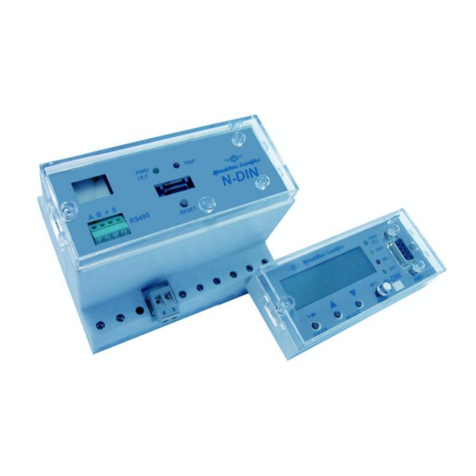
MICROENER
MICROENER N-DIN-MSG User manual

MICROENER
MICROENER ULTRA Series User manual

MICROENER
MICROENER IM30-B00 User manual
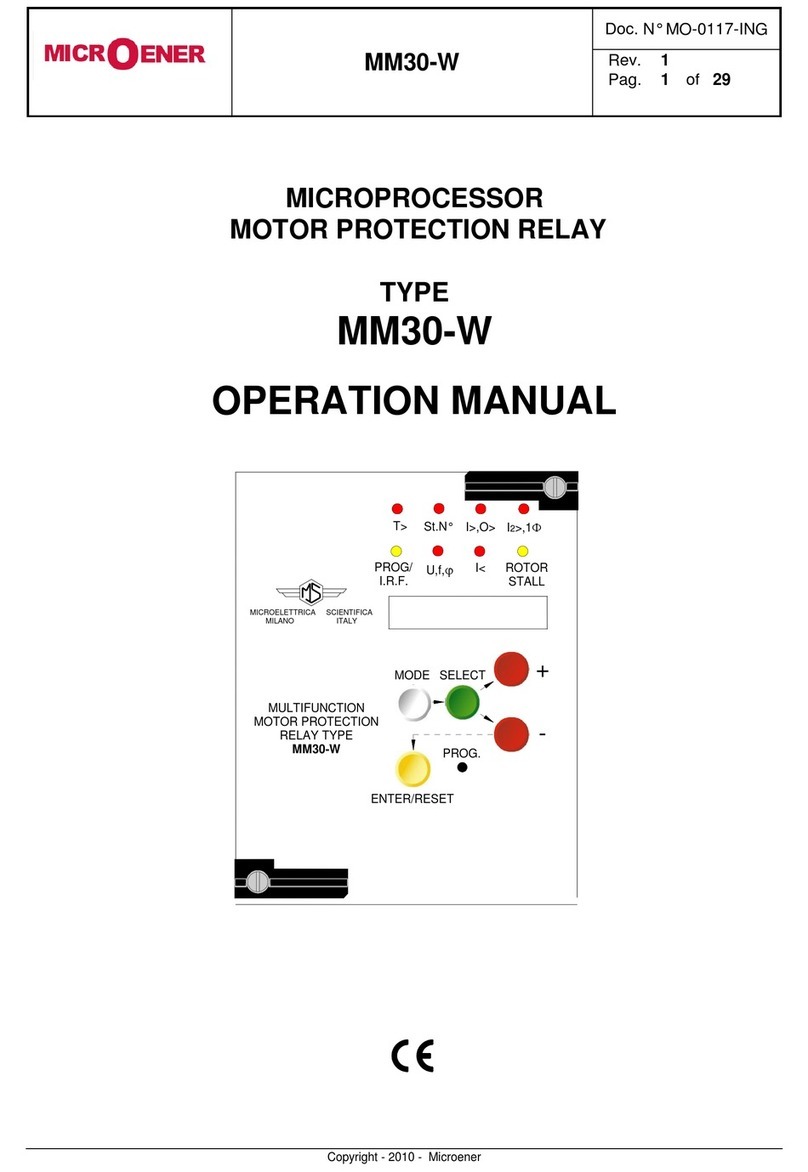
MICROENER
MICROENER MM30-W User manual
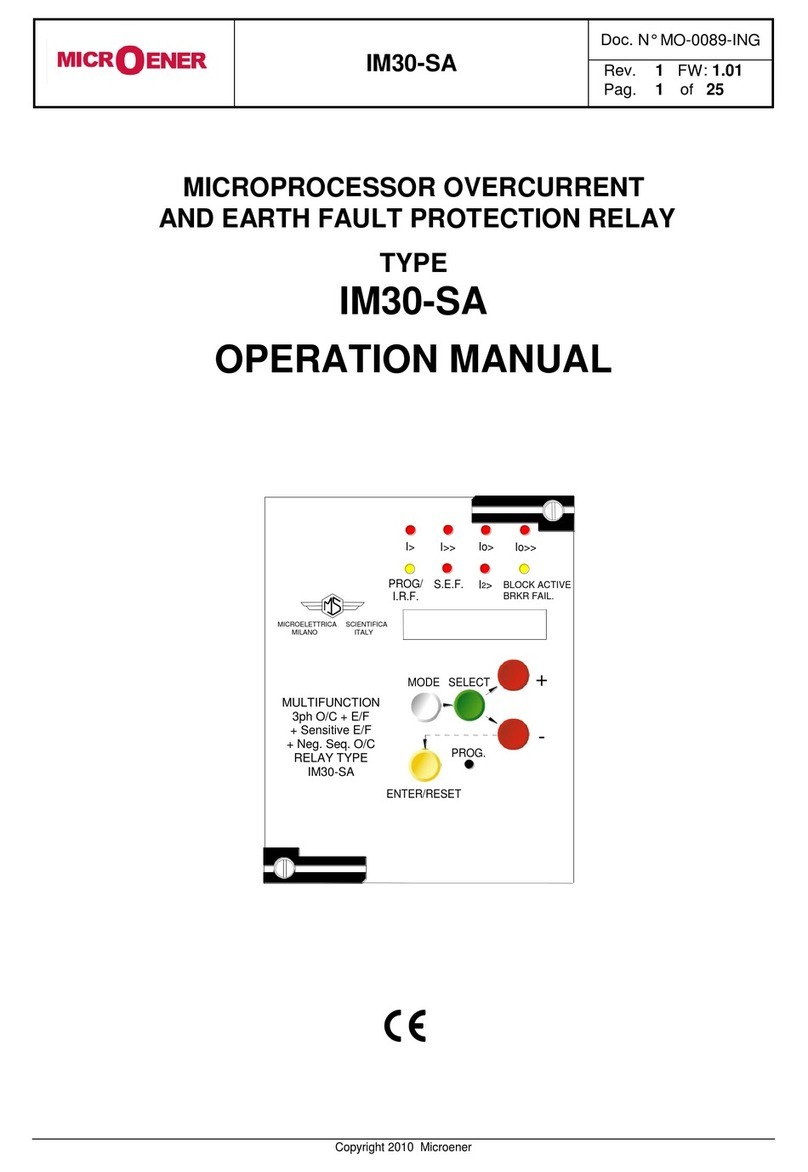
MICROENER
MICROENER IM30-SA User manual
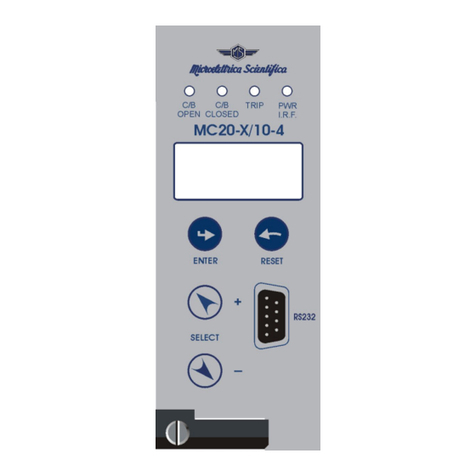
MICROENER
MICROENER MC20-X/10-4 User manual
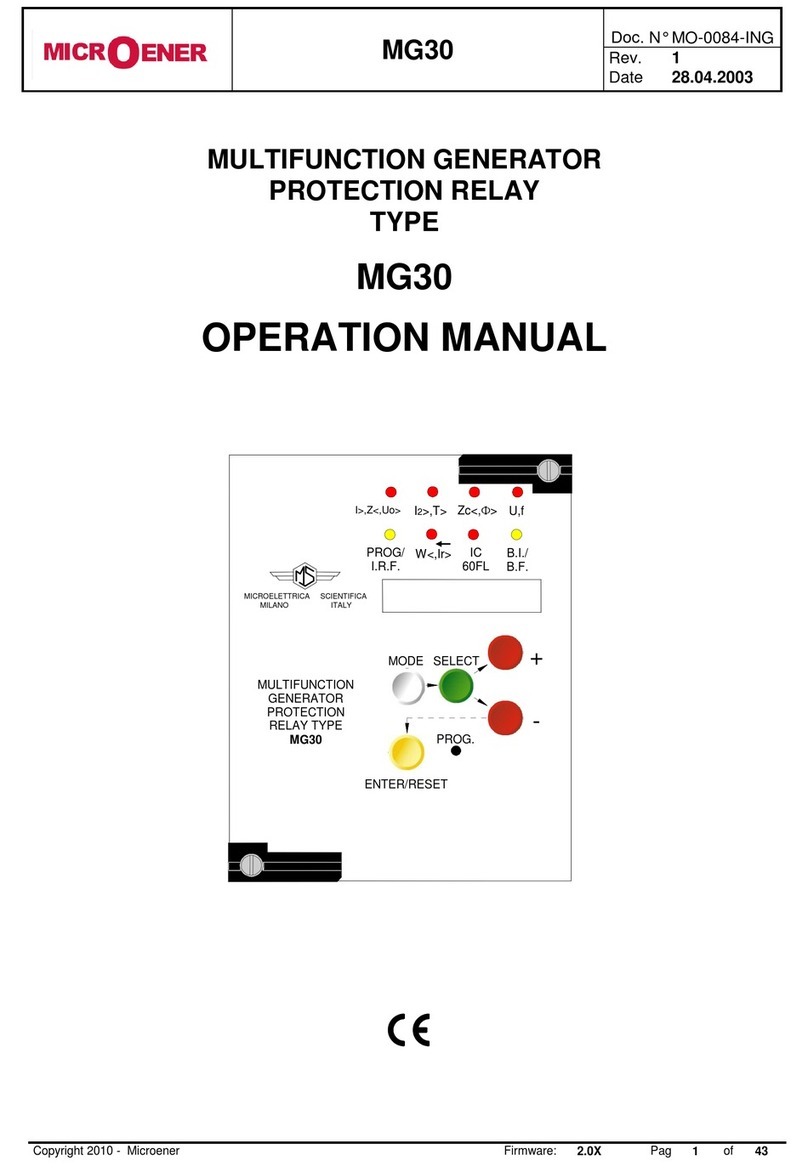
MICROENER
MICROENER MG30 User manual
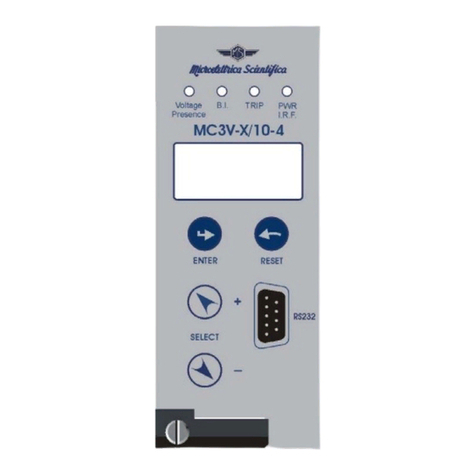
MICROENER
MICROENER MC3V-X/10-4 User manual
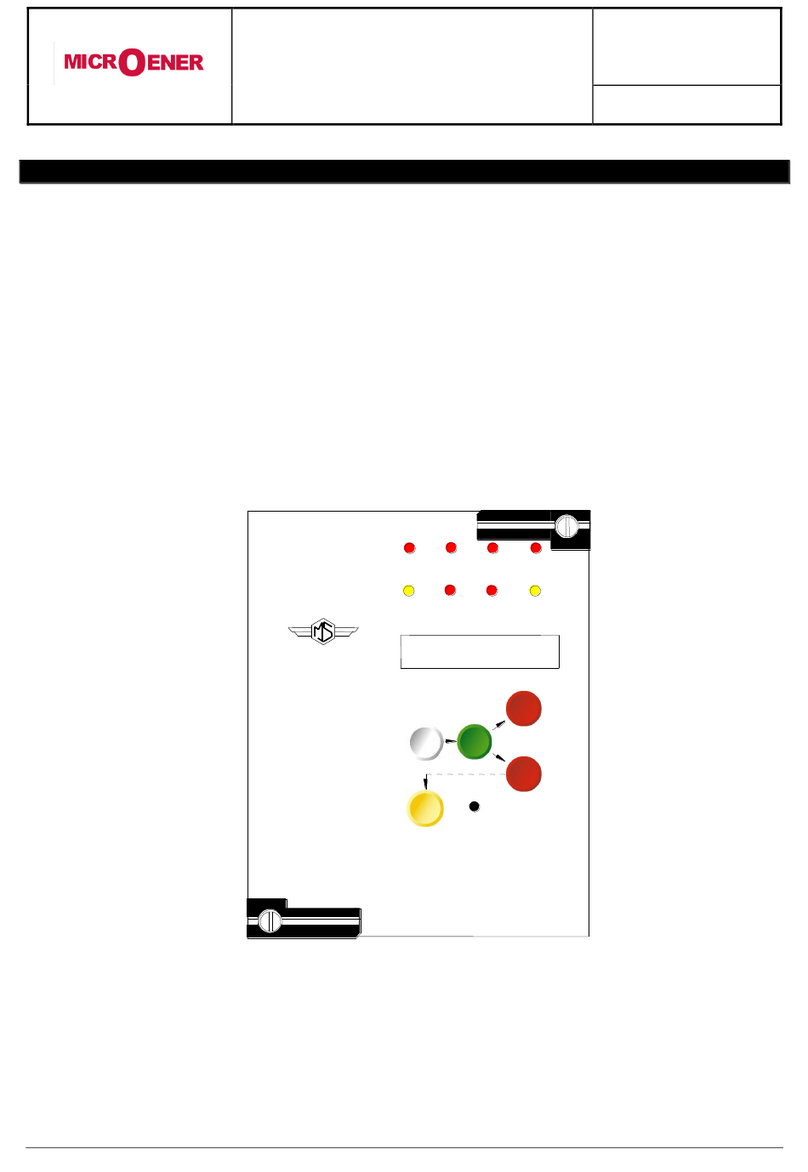
MICROENER
MICROENER M-LIB3 User manual
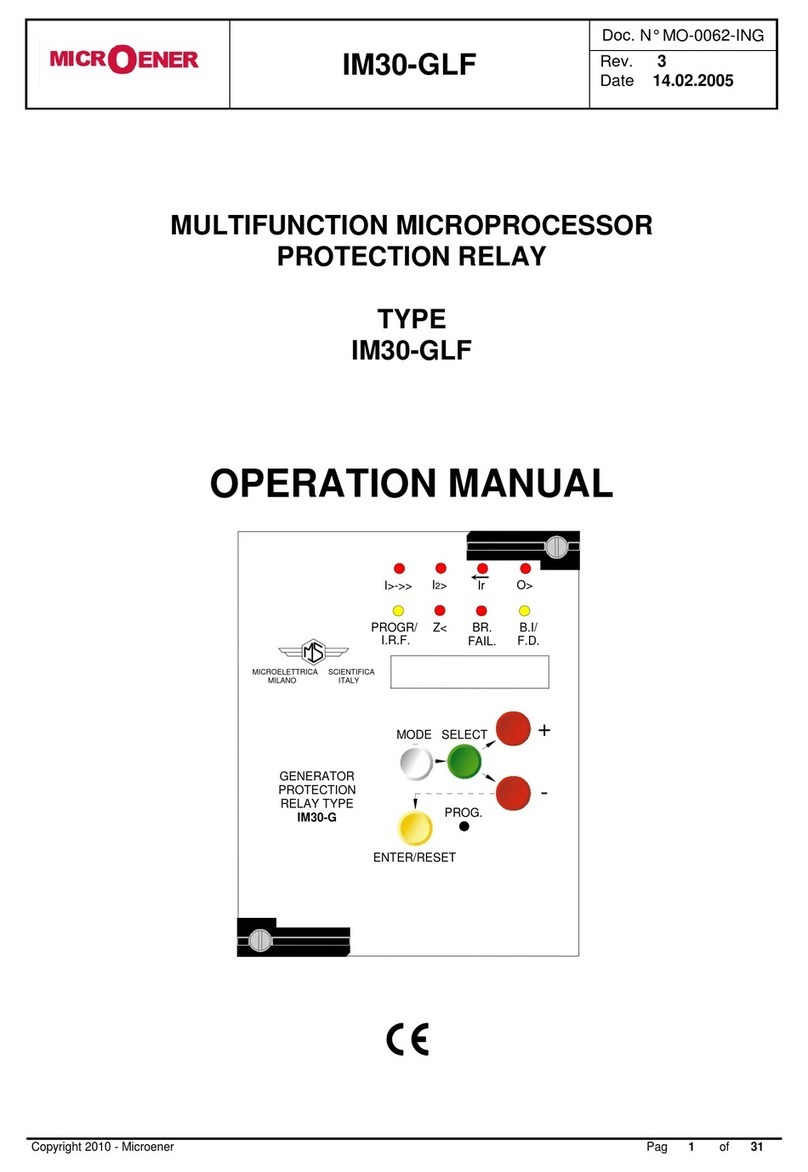
MICROENER
MICROENER IM30-GLF User manual
Popular Relay manuals by other brands

Omnitracs
Omnitracs XRS XR-980 Installation

Circutor
Circutor CBS-400B instruction manual
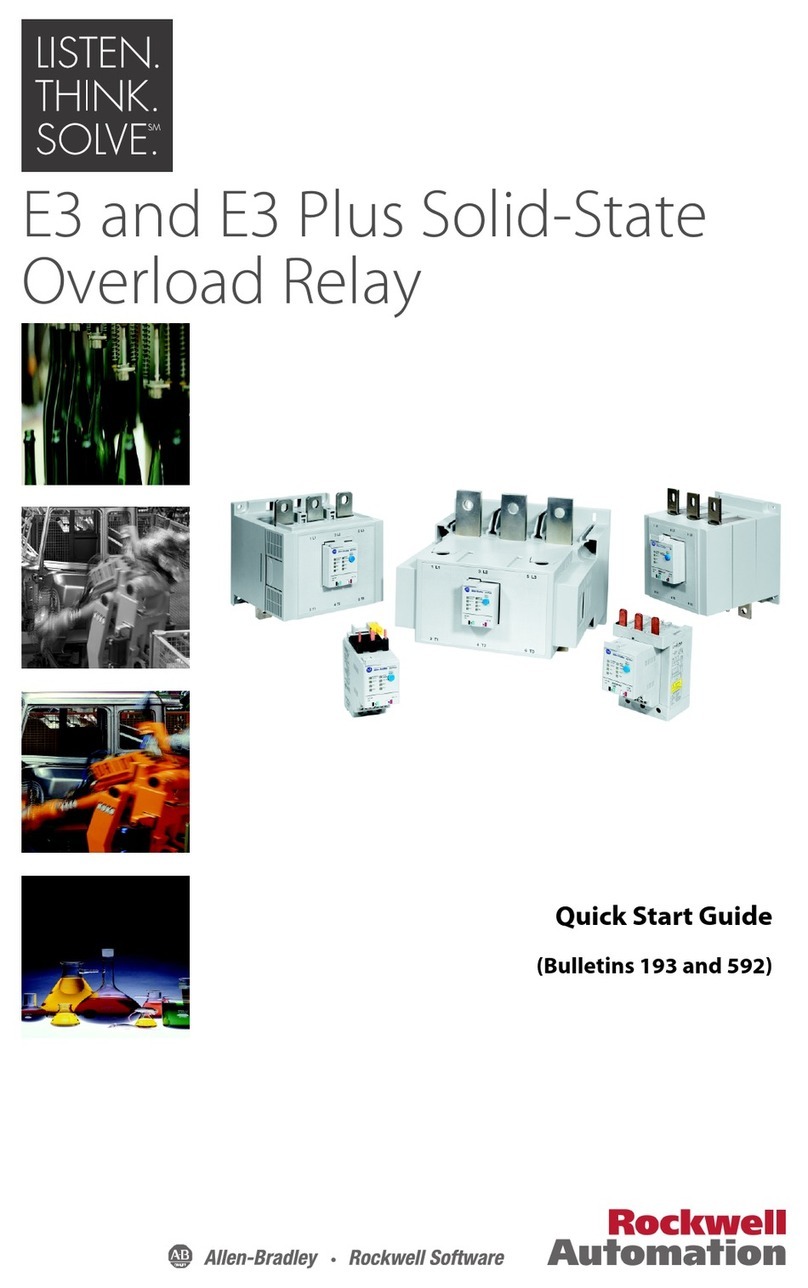
Rockwell Automation
Rockwell Automation Allen-Bradley E3 quick start guide
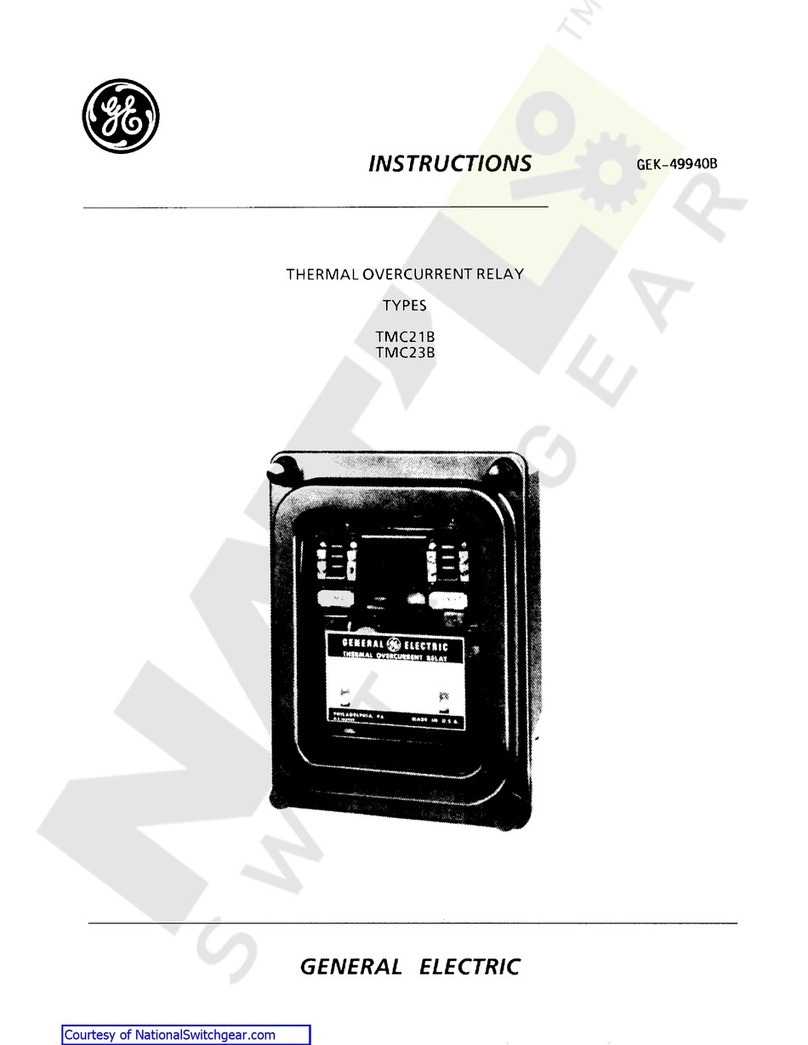
GE
GE TMC21B instructions
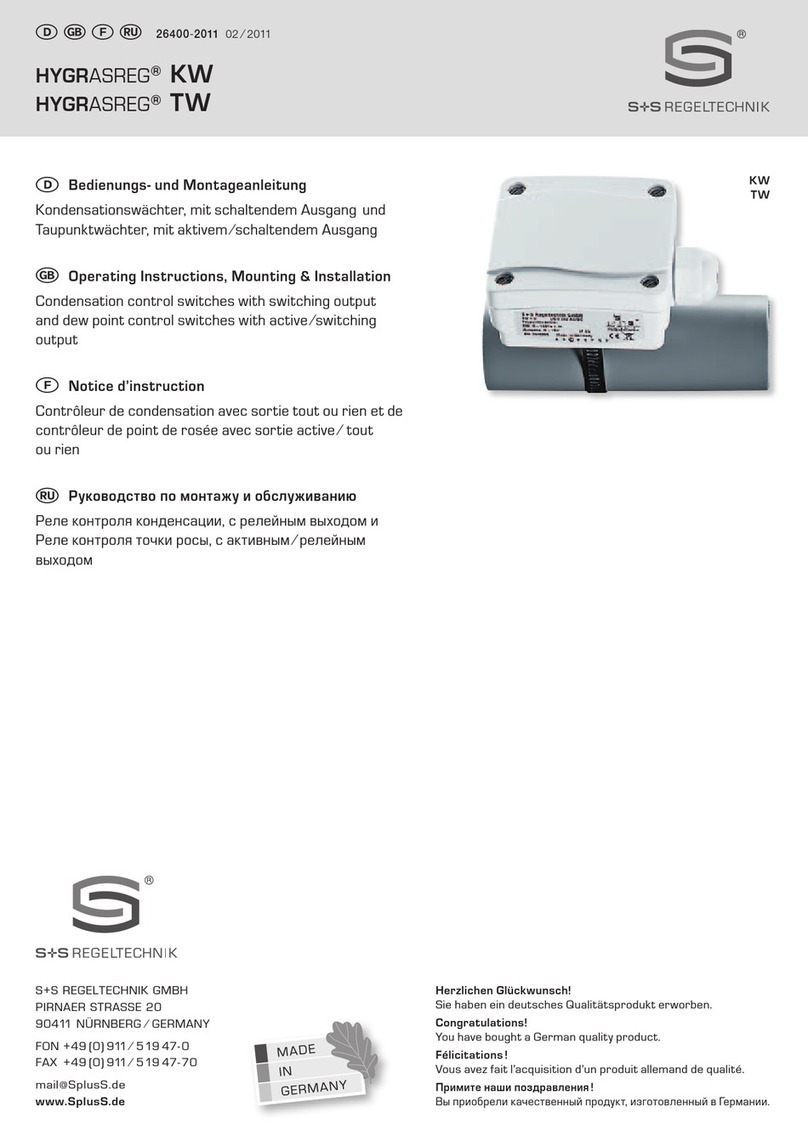
S+S Regeltechnik
S+S Regeltechnik HYGRASREG KW Operating Instructions, Mounting & Installation

NatComm
NatComm RCU-SIP user guide
